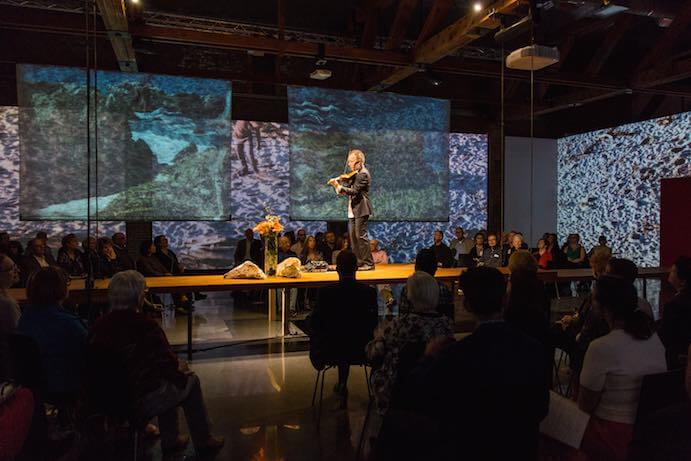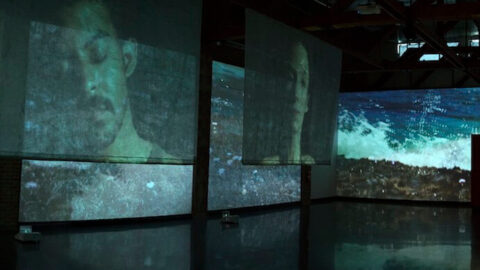Opera Omaha just took a big step towards the national spotlight on new opera with their inaugural ONE Festival. Those who fancy high-quality new, operatic work and creative audience engagement will do themselves a favor to put it in their calendars now. The more than two week creative spree delighted ears and eyes from April 6th through April 22nd and included over fifty events in all. The schedule in the elegant program booklet detailed the full range of performances, exhibitions, installations, concerts, premieres, and social events taking place in theatres, galleries, educational centers, coffee shops, and even the Fontenelle Forest.
“Artist-driven exploration of boundary-less programming” and “emphasis on experimentation” from artists who are steeped in new material and committed to theatrically vibrant work is the underpinning philosophy of the ONE Festival. When the only professional opera company in the state of Nebraska is programming newer and more diverse work in two weeks than other storied opera companies in the country are presenting in an entire season, one imagines that progress isn’t so impossible after all. When audiences rave and share their delight in the post-show talkbacks, one rethinks whether it’s really audiences who aren’t ready or hungry for new work. It is clear that Opera Omaha is deeply committed to being an organization that showcases a variety of programming spanning hundreds of years. It is also clear they are not afraid to embrace the next 400 years of what the art form could be.
Two major operas anchored the ONE Festival. The first, composer Missy Mazzoli and librettist Royce Vavrek’s Proving Up, was a co-commission by Opera Omaha specifically for the ONE Festival with Washington National Opera and the Miller Theatre at Columbia University. As an example of new work alongside traditional, yet inspired, programming, the second opera was Fiona Shaw’s production of Cherubini’s masterpiece Medea. While the ONE Festival demonstrates commitment to new and innovative works, its inaugural year cannot be said to have been committed to uproariously comedic works.
Deconstructing operatic forms; opening the artistic process
Filling out the schedule between the operatic anchors was the ONE Festival Performance Series. Opera Omaha’s general director Roger Weitz and ONE Festival artistic director James Darrah invited three artists to curate “multi-disciplinary explorations designed to deconstruct operatic forms and open the artistic process.” As with any creative adventure, some were more successful than others.

One triumphant moment of the festival was the “Evening with Tracy Silverman” at Gallery 1516 on the edges of Omaha’s Old Market. Electric violinist Tracy Silverman and filmmaker Adam Larsen paired up to present an evening of both sonic and visual charm. From Bach to Terry Riley to Silverman’s own compositions, he kept the audience spellbound. Silverman’s ease and familiarity with the technical aspects of his instrument and performing are unmistakeable. Looping doesn’t always allow one to move beyond a selective harmonic structure. Silverman subverts that stricture whenever possible by playfully altering the rhythmic structure as one example. The capstone of the evening was selections from John Adams‘ The Dharma at Big Sur (pictured above). Larsen’s soothing and affecting projections on the surrounding walls and hanging scrims of the gallery space were enjoyable overall, although some aspects may have struck an overly sentimental chord.
The entire environment is open…
The devised theatre work, The Wreck–developed during the creative team’s residency in Omaha during the festival–did not enjoy the same order, connectivity, or agreement as other ONE Festival events. The Wreck was built for the space in only ten days. That information was also given to the audience as part of the spoken audio tracks during the performance. Listeners were invited into the 1407/1409 Jackson Street gallery teeming with kitchen tables and chairs, vintage iceboxes, stoves, typewriters, and plastic rubbish installations hanging from the ceiling. International Contemporary Ensemble members playing percussion, bassoon, cello, and harp were tucked in amongst the nostalgic items. Soprano Mary Feminear and mezzo-soprano Annie Rosen brought rich, opulent vocalism to works by Verdi, Purcell, and Mariana Sadovska that made up the musical through-line of the work motivated by Rusalka mythologies, the Hans Christian Anderson ‘Little Mermaid,’ and water-inspired American poets. While the intention behind this work is admirable, an assemblage that abstains from editing is indistinguishable from creative hoarding.
It should not go unmentioned the heavy lifting that International Contemporary Ensemble provided during this two week timeframe. In addition to playing for Proving Up, Ariodante, and The Wreck, the ensemble played a number of pop-up shows at Archetype Coffee from 10:30-11:30PM as well as presenting works from their ICElab commissioning program during MAZZOLI+ and curating a deep-listening event at the Fontenelle Forest featuring Pauline Oliveros text scores. The Archetype After Hours event attracted a large and enthusiastic crowd to listen to works such as Suzanne Farrin’s Polvere et Ombra for harp as well as transcriptions/arrangements of Hildegard von Bingen by Arlen Sierra and Wendy Richman played on viola and sung by Richman.

This isn’t just a “if you build it; they will come” festival.
One important theme of the ONE Festival was the intensive focus on community engagement. The reason Opera Omaha is rapidly gaining the national spotlight is because of taking a participatory bent toward multiple programming decisions. This isn’t just a “if you build it; they will come” festival. This is a festival that is seemingly asking, “How do we invite more people in?” This type of thinking implemented preview events, pre/post performance talks thoughtfully led by staff and creative teams, interesting program notes, invitations to get more involved with the company, and visibility in the community beyond “it’s on the website.”
While not an anchor opera of the festival, ONE Festival also included open sessions of Handel’s Ariodante for community members to “drop in” and get a sense of the rehearsal and creative process leading up to performance. ONEmore was an additional series of theatrical events, concerts, and performantive responses that featured some of the ICE happenings mentioned above but also included a Healing Arts event for the patients, families, staff, students, and the public at the University of Nebraska Medical Center.
The inaugural season of any festival is not enough of a bellwether to judge or solve for long-term success. However, it is an excellent indicator of excitement for a vision to be realized. There is something special here with the ONE Festival if it can be loyally nurtured by enduring support and commitment from the financial, administrative, and artistic forces involved. If so, as Tracy Silverman quoting his wife said, “All you coastal tastemakers, flyover at your own peril.”
























